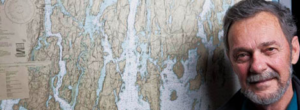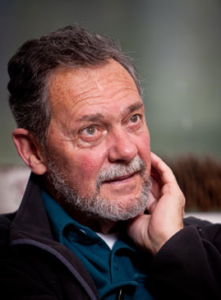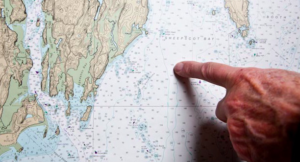
Ted Ames is a man who has made it his life’s work to study the big picture, one story at a time. Or one fish stock at a time, one fishing community, or even one fisherman.
A scientist as well as a fisherman, Ames gathered detailed accounts from retired fisherman to help him map historical changes in cod spawning grounds on the Gulf of Maine coastal shelf. His objective was to develop scientifically sound evidence about their distribution and to link them to cod population units from the same period. That could lead to more sustainable fisheries management practices—and even bring back some depleted fish stocks.
This inventive research earned him the 2005 MacArthur Award—the so-called Genius Award—and funding to continue his work.
Ames now has a full academic year at Bowdoin College as Coastal Studies Scholar-in-Residence to bring his research to the next level. While at the College, Ames is co-teaching the course Troubled Waters: Fishing in the Gulf of Maine and is participating in a five-year study with faculty from Bowdoin, Bates and University of Southern Maine who are studying past and present alewife populations in the Kennebec and Androscoggin watersheds.
Ames spoke with Bowdoin Associate Director of Academic Communication Selby Frame about big fish, little fish, and an ingeniously simple plan that could help crank up New England’s devastated commercial fishery.
SF: What was that like for you winning the MacArthur Award? Did you have any clue it was coming?
TA: A great surprise. It came out of the blue. I got a phone call around dinnertime. I didn’t believe the person at first; I thought it was perhaps a joke some of my friends were pulling on me. The caller said, “You’ve just received this prestigious five-year award complete with a generous stipend.” I said, “That’s great, thank you very much,” not expecting to hear any more about it. I went to the kitchen and told my wife and she wasn’t aware that anything had been in the works. It’s really interesting because you end up getting this award but you don’t know who recommended you or even who the MacArthur people sent around to vet their recommendation.
SF: I’m wondering how it changed what you were doing, and if people in the fishing community reacted to it.
 TA: It was transformational. I’ve been able to do quite a lot of research and we were able to start The Penobscot East Resource Center and lobster hatchery, which fisherman wanted at the time. It was very constructive time for me, but suddenly I was thrust in the middle of all this interaction, much more than I was accustomed to. I think we fishermen tend to be more insular as a group than a lot of people, so it’s been kind of a reality check. In some ways it’s retarded the work I was doing and in other ways, it has facilitated all kinds of things I probably never would have done without it. This opportunity at Bowdoin is a good example of that.
TA: It was transformational. I’ve been able to do quite a lot of research and we were able to start The Penobscot East Resource Center and lobster hatchery, which fisherman wanted at the time. It was very constructive time for me, but suddenly I was thrust in the middle of all this interaction, much more than I was accustomed to. I think we fishermen tend to be more insular as a group than a lot of people, so it’s been kind of a reality check. In some ways it’s retarded the work I was doing and in other ways, it has facilitated all kinds of things I probably never would have done without it. This opportunity at Bowdoin is a good example of that.
SF: I understand that you interviewed nearly 30 old-timers who had fished the Gulf of Maine to help you reconstruct the historic reach and density of cod and haddock spawning grounds. Can you give me an idea of the difference between then and now?
TA: Many of those grand old pirates that I interviewed are now dead, and so much of that knowledge they had has disappeared with them. But they shared incredible information that made a wonderful time capsule of what their fishery used to be.
The abundance we once had, compared to today was staggering.
I’ve got a film of a 1970s haking trip from Vinalhaven a friend of mine made in his lobster boat. Fishing for white hake in the summer was a traditional summer fishery for the island. He returned with a fairly good trip of 8,000-9,000 pounds for the day. When you tell people about fisheries like that, they find it hard to believe. Today, its doubtful if a similar boat could catch that many fish in a week. Five years ago, fishermen from mid-coast Maine to Canada were already complaining that they needed to go at least 50 to 100 miles offshore before even beginning to look for fish. We’ve really fouled up the system, but if we brought it back…
SF: How have fisheries management folks dealt with the collapsed system?
TA: It’s the most incredible thing. Up to this point, the only mechanism that fisheries management has had in the past is… if there’s no fish, well, we’ll just stop fishing in the whole 35,000 square-mile Gulf of Maine, and put hundreds of people out of work.
Today, the whole northern shelf of the Gulf of Maine, nearly the size of George’s Bank hasn’t had a viable groundfish fishery for 25 years. Mostly because the fish are gone. While overfishing was a major contributor to the collapse, there are undoubtedly other reasons why this has happened. Learning what the missing parts are may help the effort to restore the fish stocks that once made New England fishing grounds notoriously productive.
SF: How does your current research start to answer these questions?
 TA: I’m studying the connection between alewives and the groundfish that once preyed on them as a link between riverine and marine ecosystems. I’ve been examining the 1920s distribution patterns and movements of the cod family near two smaller Maine rivers that reported alewife runs during the same period to clarify their predator-prey relationship. They are the only Maine rivers with documented alewife landings in the 1920s so it makes a perfect study site.
TA: I’m studying the connection between alewives and the groundfish that once preyed on them as a link between riverine and marine ecosystems. I’ve been examining the 1920s distribution patterns and movements of the cod family near two smaller Maine rivers that reported alewife runs during the same period to clarify their predator-prey relationship. They are the only Maine rivers with documented alewife landings in the 1920s so it makes a perfect study site.
So far, I’ve completed the analysis of four species — cod, haddock, pollock and white hake. All of them moved inshore in the fall, rather than moving offshore as do today’s fish, After the rivers were dammed in the mid-19th century, the alewives disappeared. When alewives weren’t there, inshore populations of cod disappeared, which suggests that you may need alewives swimming up those rivers in order to have a commercial fishery for these groundfish on the bordering coastal shelf.
SF: So, the robustness of New England fishing stocks of old can be traced largely to Maine’s rivers?
TA: My research suggests that. The Kennebec and Androscoggin runs of alewives were estimated to have 15 million adults swimming up the river each year. Each female alewife produces 100,00 to 150,000 eggs that result in billions of progeny swimming down the river. Further down the coast, the Penobscot River were estimated to produce 30 million adult alewives per year and the St. Croix produced another 25 million — never mind the progeny. This biomass, on top of the Atlantic herring reproducing onshore, created one big soup of prey for the cod and haddock.
SF: If the alewives can make a return — as they are starting to do on a small scale on rivers such as the Damariscotta — you think this could make a substantial impact on the return of ground fish stocks and fisheries?
TA: If you look at alewives as a major reason why large coastal populations of cod, pollock and haddock were here, then you’re looking at a powerful economic engine and an opportunity to not only create a sustainable fishery, but to greatly multiply the amount of fish we can take out of the system each year. If this is correct, and after the research I’ve done at Bowdoin completes peer review, it may mean that managers have a new tool to rebuild populations of cod, pollock and haddock in areas where they haven’t had any in decades, even centuries.
SF: Tell me a little more about your work at Bowdoin, how that piece fits in.
TA: Oh, for me it’s a great adventure. A year with a chance to do all the work I haven’t been able to finish because my GIS program hasn’t been robust enough. I’m getting great support from a very capable staff and from student researchers who are helping me do some pretty sophisticated things.
 We’re integrating fine scale marine geology information from maps along the coastal shelf to vet the historical analysis that 1920s fishermen reported. We’re trying to evaluate them according to substrate type and ultimately to make an estimate of how many fish the system appeared to support back in the 1920s. From there, we can perhaps develop a model to project/predict how many fish a restored system could sustain and harvest.
We’re integrating fine scale marine geology information from maps along the coastal shelf to vet the historical analysis that 1920s fishermen reported. We’re trying to evaluate them according to substrate type and ultimately to make an estimate of how many fish the system appeared to support back in the 1920s. From there, we can perhaps develop a model to project/predict how many fish a restored system could sustain and harvest.
SF: So then, this is kind of the flip side – or scientific corroboration – of what those old fishermen told you?
TA: The reality of management is they are required to use the best peer-reviewed science available to justify their regulations. This research, when its finished, will go into that pool of scientific knowledge and hopefully will provide new strategies for dealing with the depletion issue. Me, I’m looking at the alewife connection and thinking it’s the coolest thing since toast. Can’t believe we’ve stumbled on something as potentially important to managing coastal and river fisheries as this.”
All photos by Brian Wedge.